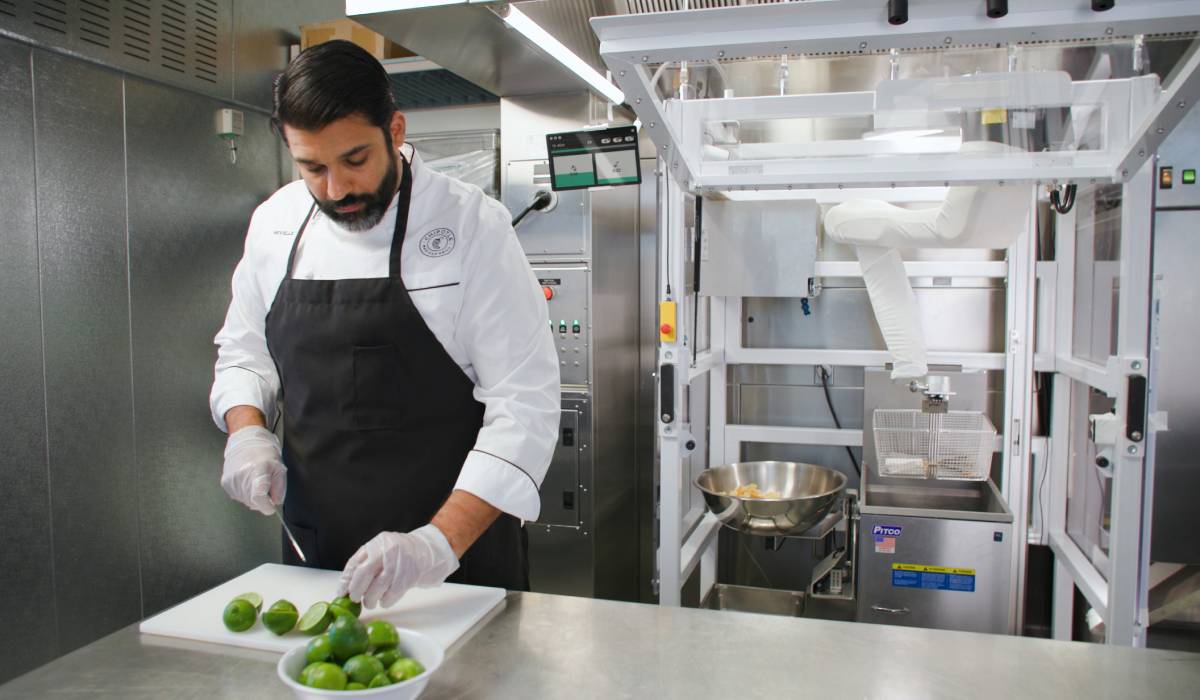Chipotle is joining a robotics movement fast gaining relevance for restaurants, a kickback to soaring labor costs, the rush to improve hourly job conditions, and a climate where operators are countering rising costs with efficiencies.
The fast casual Wednesday announced it’s testing “Chippy,” an autonomous kitchen assistant from Miso Robotics that makes tortilla chips. “We are always exploring opportunities to enhance our employee and guest experience. Our goal is to drive efficiencies through collaborative robotics that will enable Chipotle’s crew members to focus on other tasks in the restaurant,” said Curt Garner, Chipotle’s chief technology officer, in a statement.
Chipotle said its culinary team guided Miso Robotics, perhaps best known for its “Flippy” fry-cooking robot, which White Castle is adding to 100 locations, in tailoring the technology to “maintain the culinary integrity of the brand.”
Using artificial intelligence, “Chippy” can replicate Chipotle’s exact recipe—corn masa flour, water, and sunflower oil—to cook chips, season with salt, and finish with a hint of lime juice. “It was imperative that the technique remained the same so customers receive delicious, craveable chips every time,” the company said.
“Everyone loves finding a chip with a little more salt or an extra hint of lime,” added Nevielle Panthaky, Chipotle’s VP of culinary. “To ensure we didn’t lose the humanity behind our culinary experience, we trained Chippy extensively to ensure the output mirrored our current product, delivering some subtle variations in flavor that our guests expect.”
“Chippy” is currently piloting at Chipotle’s “Cultivate Center,” an innovation hub in Irvine, California. The brand said it will integrate it into a restaurant in Southern California later this year. In terms of going national, like always with Chipotle, the brand is leveraging a “stage-gate process” to gather customer and employee feedback before going forward.
“When Chipotle challenged us to see if our technology could meet the brand’s high standards for culinary quality, we couldn’t wait to flex our engineering and design muscles,” Mike Bell, Miso Robotics’ CEO, said in a statement. “This partnership will allow us to move into new territory to help improve back-of-house functions and assist team members with their day-to-day responsibilities.”
Chipotle has already dipped into AI with its concierge chat bot, “Pepper,” which is live on its app and website and fields questions from guests. “The company believes technology deployed consistently and correctly can improve the human experience,” Chipotle said.
In Q4, Chipotle reported its labor costs took a hit of 11 basis points, up to 26.4 percent, as the company lifted average wages to $15 per hour in May.
Chipotle offset the cost, as well as commodity pressures (namely, beef inflation and freight, to a lesser extent), with a 4 percent mid-December menu price increase that gave the chain about 10 percent of price in January. CEO Brian Niccol said in February Chipotle could take additional pricing in 2022 if costs don’t abate.
The company is also in the process of implementing a new digital scheduling program and upgrading its learning management portal. The former uses artificial intelligence and analytics that looks at real-time metrics and helps employees prep accordingly.
In its Q4 recap, Niccol was asked if Chipotle would explore further automation. He hinted it would, saying whether its robotics or automation, technology that sheds “jobs people frankly don’t love doing” was on the brand’s radar. It was also unfolding behind the scenes.
Fueled by digital and continued growth (Chipotle opened 215 new restaurants in 2021 and 78 in Q4 alone), the brand’s total revenue last year upped 26.1 percent to $7.5 billion. Same-store sales climbed 19.3 percent and digital sales upped 24.7 percent (45.6 percent of the business).
In Q4, revenue rose 22 percent, year-over-year, to $2 billion, and comps hiked 15.2 percent. Digital sales, even against 2021’s skyrocket, ticked up 3.8 percent to 41.6 percent of sales ($811 million, with delivery mixing about 20 percent).
For reference, Chipotle’s full-year digital sales of $3.4 billion was nearly three-and-half times what it reported pre-COVID in 2019. And this despite the fact two-thirds of guests still use in-restaurant as their exclusive channel.
In addition, Chipotle today has more than 26.5 million loyalty members. It touted 8.5 million in February 2020.






